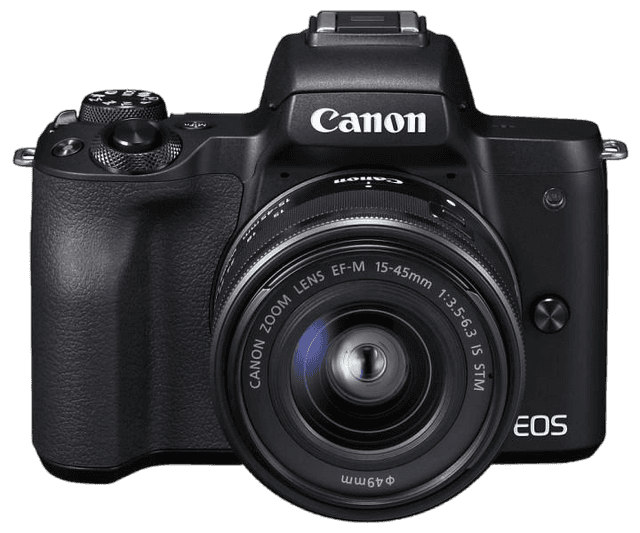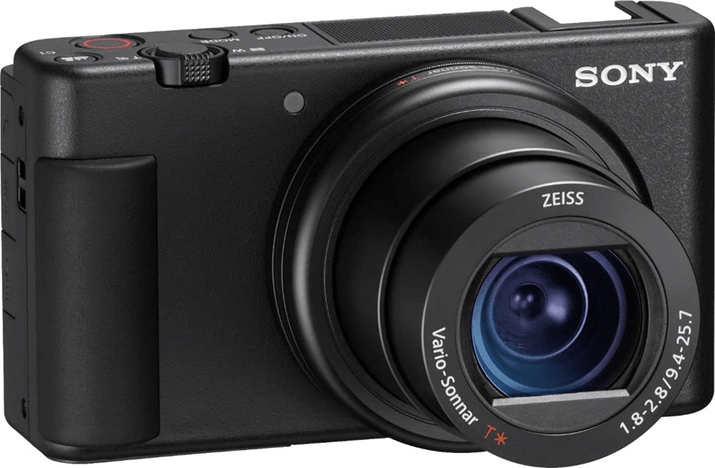Canon EOS M50 vs Sony ZV-1 Comparison
Canon EOS M50

Sony ZV-1

The Sony ZV-1 takes the lead with a score of 65/100, while the Canon EOS M50 trails behind at 59/100. Both cameras share similarities, such as being released within two years of each other and having similar launch prices ($800 for the ZV-1 and $779 for the EOS M50).
The Sony ZV-1 outperforms the Canon EOS M50 in terms of size and weight, being smaller (105 x 60 x 44mm) and lighter (294g) than the EOS M50 (116 x 88 x 59mm and 390g). This makes the ZV-1 more portable and convenient for on-the-go photography.
However, the Canon EOS M50 has its advantages as a mirrorless camera, offering more flexibility in lens options compared to the Sony ZV-1’s compact design. This could make the EOS M50 more appealing for those seeking versatile shooting experiences.
Taking these factors into account, the Sony ZV-1’s compact design and lighter weight make it an ideal choice for those prioritizing portability, while the Canon EOS M50’s mirrorless features cater to photographers wanting more lens options.
Canon EOS M50 vs Sony ZV-1 Overview and Optics
The Sony ZV-1 outperforms the Canon EOS M50 in optics with a score of 67/100 compared to the M50’s 59/100. Both cameras share some common specifications, including a CMOS sensor and a similar megapixel count (24 for the M50 and 20 for the ZV-1). Additionally, both cameras have powerful processors, with the M50 featuring a Digic 8 and the ZV-1 a Bionz X processor.
The Sony ZV-1 excels in several areas, most notably with its higher DXOMARK sensor score of 82, compared to the M50’s 58. This difference points to better image quality from the ZV-1. Furthermore, the ZV-1 has a significantly faster shooting speed of 24, while the M50 trails at 10. The Sony ZV-1 also includes image stabilization, a feature absent in the Canon EOS M50.
The Canon EOS M50, on the other hand, boasts a larger APS-C sensor size, which typically results in better low-light performance and higher dynamic range. The M50 also comes equipped with a Canon EF-M lens mount, allowing users to change lenses for various shooting scenarios. The Sony ZV-1 has a fixed lens mount, limiting its versatility in this regard.
Taking these factors into account, the Sony ZV-1 emerges as the better option for photographers prioritizing image quality, fast shooting speeds, and image stabilization. Meanwhile, the Canon EOS M50 offers a larger sensor size and interchangeable lenses, making it a more flexible choice for those who value versatility in their photography.
Canon EOS M50 vs Sony ZV-1 Video Performance
The Canon EOS M50 and Sony ZV-1 both have a video score of 91/100, making them equal in terms of video capabilities. They share common specifications, such as a maximum video resolution of 4K and maximum video dimensions of 3840 x 2160. Additionally, both cameras have a maximum video frame rate of 120fps and built-in time-lapse functionality.
Despite having the same video score, there are areas in which one camera outshines the other. The Canon EOS M50 offers an interchangeable lens system, providing users with more flexibility in choosing lenses for different shooting scenarios. This feature allows for greater creative control and adaptability, which is beneficial for various video projects.
On the other hand, the Sony ZV-1 excels in its compact design and user-friendly features, making it an ideal choice for vloggers and content creators who value portability and ease of use. The ZV-1 also boasts a fast autofocus system, ensuring that subjects remain sharp and in focus during video recording.
When comparing the two cameras, it is clear that the Canon EOS M50 is better suited for those who prioritize flexibility and creative control through its interchangeable lens system. The Sony ZV-1, however, is a more suitable option for vloggers and content creators who value a compact design and user-friendly features. Since both cameras have the same video score, the decision ultimately comes down to the user’s specific needs and preferences.
Canon EOS M50 vs Sony ZV-1 Features and Benefits
The Canon EOS M50 takes the lead in features with a score of 70/100, while the Sony ZV-1 follows closely with a score of 68/100. Both cameras share several specifications, making them quite similar in terms of features. They both have 3-inch touchscreens, flip screens, and lack GPS. Additionally, both cameras offer Wi-Fi and Bluetooth connectivity.
The Canon EOS M50 outperforms the Sony ZV-1 in screen resolution, boasting 1,040,000 dots compared to the ZV-1’s 921,600 dots. This higher resolution allows for crisper and clearer image previews and better menu navigation on the M50.
On the other hand, the Sony ZV-1 still holds its ground despite the slightly lower feature score. It matches the Canon EOS M50 in terms of screen size, touchscreen capabilities, flip screen, and connectivity options. Although it has a slightly lower screen resolution, the difference may not be significant enough to impact user experience heavily.
To conclude, the Canon EOS M50 and Sony ZV-1 are quite comparable in their features, with only a minor difference in their scores. The M50 takes a slight lead due to its higher screen resolution, providing a better viewing experience. However, the Sony ZV-1 remains competitive, offering similar specifications in other areas. Ultimately, potential buyers should consider which features are the most important to them and choose the camera that best suits their needs.
Canon EOS M50 vs Sony ZV-1 Storage and Battery
The Sony ZV-1 outperforms the Canon EOS M50 in storage and battery with a score of 29 to 13. Both cameras share similarities, including a single memory card slot and compatibility with SD, SDHC, and SDXC cards.
The Sony ZV-1 surpasses the Canon EOS M50 in battery life, delivering 260 shots compared to the M50’s 235 shots. Additionally, the ZV-1 offers USB charging, a feature absent in the M50. These advantages make the ZV-1 more convenient for extended shooting sessions.
The Canon EOS M50 does not hold any advantages over the Sony ZV-1 in storage and battery. However, it is important to consider other factors when choosing a camera, as this comparison only focuses on storage and battery performance.
Considering these points, the Sony ZV-1 proves to be the superior choice for users prioritizing storage and battery capabilities.
Canon EOS M50 vs Sony ZV-1 Alternatives
Still not sure which camera is best for you? Check out some more popular camera comparisons for inspiration:
